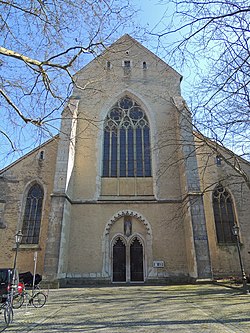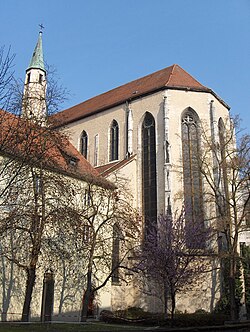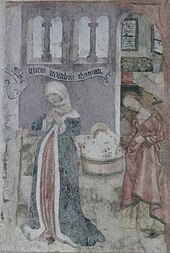Dominican Church of St. Blasius (Regensburg)
The Dominican Church of St. Blasius in the western old town of Regensburg , located on a large area between the alleys Am Ölberg, Predigergasse and the squares Bismarckplatz , Albertus-Magnus-Platz and Aegidienplatz , was built in more than a hundred years, starting in 1229, as a church of the Dominicans erected. The church is one of the main early Gothic works in Germany and is one of the largest Dominican churches. It is twice as high as the customs of the order at the time required, which has led to great static problems over the centuries. Today the church is the congregation church of the Marian Men's Congregation Regensburg .
Construction and equipment
The decidedly simple church is a mighty three-aisled Gothic basilica without a transept, 73 m long and 25 m wide. As is usual with Bettelordenskirchen , there is no high church tower , but the existing roof tower is more than a simple roof turret . The nave has six yokes. The main choir with four bays protruding to the east is flanked on both sides by side choirs with three bays each. The long aisles are designed with ribbed vaults. An originally existing rood screen was removed so that today the view extends from the portal to the main choir. Altar and pulpit were created in the course of the regotization in 1869. In the north choir there is a second portal with a rose window. Particularly noticeable are the figures who support the services on the service capitals. The easternmost service figure shows a kneeling monk in the girdled robe of the Dominicans. The right hand carries a straight edge and a large circle as an attribute of his work as a construction manager in the construction of the church. Next to the figure in a cuboid is the inscription "Brother Diemar". Several animal sculptures on the eastern buttress date from around 1280.
A niche opposite with a later worked opening to the choir made it possible for the beguines supervised by the Dominicans to follow the service in the choir. The choir is furnished with choir stalls from the late 15th century. The walls above and behind the stalls bear frescoes from the early 14th and late 15th centuries. In the south aisle there is a neo-Gothic passage to the sacristy. The cloister from the 13th century adjoins it. A 16-part fresco at the west end of the south wall comes from the 15th or 16th, a bust reliquary by Albertus Magnus in a side altar from the late 17th century.
As early as the 17th century, the height of the church and the lack of internal bracing of the walls meant that the high side walls had drifted apart due to the load on the roof. Attempts to stop the walls from drifting apart by installing a second roof truss failed and were reversed in the 19th century. The concept has been pursued since 2015 to stabilize the existing condition by installing steel cables and steel girders. Therefore, the church will not be accessible again until the end of 2020.
organ
Above the entrance portal is a baroque gallery with a baroque organ front (around 1727) with a work by Willibald Siemann from 1904.
history
In 1229, the Dominican mendicant monks were called to Regensburg by Bishop Siegfried of Regensburg , a follower of Emperor Friedrich II. , After donating their own church and farmsteads with land. After Trier, Koblenz, Strasbourg and Magdeburg, the order began to build its fifth monastery on German soil here. The starting point was the construction of the church on the western outskirts of Regensburg while still inside the Arnulfini city wall. In the course of the following years, further buildings of the monastery and courtyards were grouped around the church. A closed monastery area was created, which led to the fact that the city of Regensburg forbade the order to acquire further properties in 1306. Like the other mendicant orders, the Dominicans were not subject to episcopal or municipal jurisdiction and enjoyed great popularity among the population, from whom they received material and financial help.
In the early years of the establishment, the presence of Albertus Magnus was of particular importance. The scholar worked as a lecturer in the convent of the monastery from 1237 to 1240 and was bishop of Regensburg from 1260 to 1262. With the construction of a library he became one of the founders of the scientific importance of the monastery. The library was in the heyday of the monastery after 1350 in Regensburg, only surpassed by the monastic libraries of St. Emmeram and Prüfening . In the late 15th century, the monastery was one of the largest Dominican monasteries in the empire with 49 conventuals. In the following period of the beginning of the Reformation and the expulsion of the Jews from Regensburg, the burial of the Imperial Governor Thomas Fuchs von Wallburg took place in the Dominican Church, whose grave was decorated with an epitaph.

During the time of the Reformation , from 1542 onwards, the monastery suffered financial decline and monks emigrated because many of the previous testamentary legacies and other gifts of the citizens did not materialize. Due to the lack of Protestant churches and because of the strong demand for Protestant worship, the Dominican Church, which had been abandoned by most of the monks, was used as a simultaneous church after 1563, following a decision by the City Council of Regensburg . The nave was available for Protestant services, the choir area, separated by a curtain, was left to the monks who remained in the Dominican monastery. In the course of the recatholicization at the beginning of the Thirty Years War , the Dominicans had the common use of their church prohibited by the Reichshofrat in 1626 . A transition period was only granted until 1628. As a result, the Council of the City of Regensburg decided in February 1627 to give up the use of the Dominican Church for Protestant services in return for payment of 6,000 guilders. As a replacement, construction began on the Trinity Church , which was completed at the end of 1631. During the Swedish occupation of Regensburg in the Thirty Years War, billeting in the church, further financial losses and structural destruction occurred. The monastery deteriorated more and more and was dissolved in 1806 during the reign of Prince Bishop Carl Theodor von Dalberg . The church became the Congregational Church of the Marian Congregation for Men in 1810. From 1966 to 1971, restoration work was carried out in the church, which continued at the beginning of the 20th century and has started again since 2015.
After the monastery was closed, the monastery buildings at Aegidienplatz 1 housed a boys' school, a lyceum and the Philosophical-Theological College, which later became the Catholic-Theological Faculty of the University of Regensburg , which was housed there until 1973. From 1875 the new Königlich-Bayerische Gymnasium moved into a new domicile there on the Aegidienplatz, which was renamed in 1880 first in 'Altes Gymnasium and in 1962 in Albertus-Magnus-Gymnasium and in 1965 moved into a new building in the west of the city.
monastery
The cloister and a former lecture hall with medieval chairs for professors and assistants, which today serves as the Albertus Magnus Chapel, have been preserved from the medieval monastery .
Web links
Individual evidence
- ^ A b Peter Morsbach: Regensburg churches, a leader . Pustet Verlag, Regensburg 1990, ISBN 3-7917-1253-5 , p. 14-18 .
- ^ Karl Bauer: Regensburg Art, Culture and Everyday History . 6th edition. MZ-Buchverlag in H. Gietl Verlag & Publication Service GmbH, Regenstauf 2014, ISBN 978-3-86646-300-4 , p. 497-499 .
-
^ Regensburg, Dominican monastery St. Blasius , basic data and history:
Peter Morsbach: The Dominican monastery St. Blasius - the nucleus of the University of Regensburg in the database of monasteries in Bavaria in the House of Bavarian History
Coordinates: 49 ° 1 ′ 5 ″ N , 12 ° 5 ′ 27 ″ E






